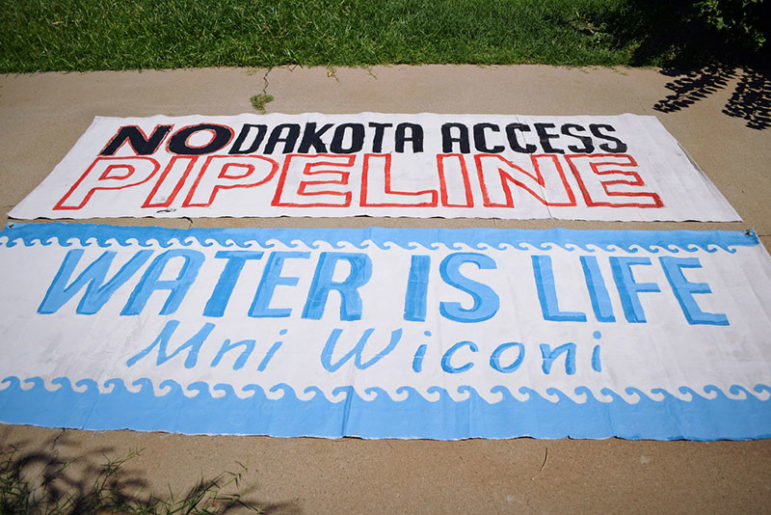
October 20, 2016; Guardian
The Dakota Access pipeline protests began with a Standing Rock Sioux youth-led petition called Rezpect Our Water. Their earnest protest became an international cause célèbre and a celebrity cause. There is, of course, a long history of such causes where celebrities take a stand en masse—many times, to very good stead.
The Justice League movie’s cast members and Leonardo DiCaprio have spoken out in opposition to the pipeline. Bernie Sanders and four Senate Democrats issued a letter to President Barack Obama making demands. Authorities issued a warrant for the arrest of journalist Amy Goodman of Democracy Now! after she filmed guards for the Dakota Access pipeline using dogs and pepper spray on protesters. A North Dakota judge subsequently rejected prosecutors’ “riot” charges against Goodman, a decision that at least temporarily upheld freedom of the press.
On October 10, actress Shailene Woodley, star of the Divergent series and most recently Snowden, was arrested along with 26 other people for criminal trespassing. (Her video of the arrest has nearly 5 million views at this writing.) Recently released on bail, Woodley wrote this essay about her experience for Time. She will stand trial in January. If convicted, she could face up to 60 days in jail and a $3,000 fine. In an interview with the website Democracy Now! on Sunday, she said she was strip-searched at the Morton County jail.
Events took a more chilling turn when documentary filmmakers Deia Schlosberg and Lindsey Grayzel were separately charged with felony conspiracy and taken into custody for reporting on U.S. oil pipeline protests in North Dakota and Washington State respectively.
Here is an October 24th video interview by Amy Goodman of Democracy Now! with Schlosberg. Schlosberg is facing three felony conspiracy charges that could result in a 45-year prison sentence. Edward Snowden tweeted his support of Schlosberg, writing, “This reporter is being prosecuted for covering the North Dakota oil protests. For reference, I face a mere 30 years.”
Neil Young, actor Mark Ruffalo, and more than 30 other artists, filmmakers, writers and journalists joined Oscar-nominated director Josh Fox, who produced “How to Let Go of the World” with Schlosberg, in signing an open letter to President Barack Obama and North Dakota Governor Jack Dalrymple that the charges against Schlosberg were “unfair, unjust and illegal.”
Sign up for our free newsletters
Subscribe to NPQ's newsletters to have our top stories delivered directly to your inbox.
By signing up, you agree to our privacy policy and terms of use, and to receive messages from NPQ and our partners.
The Guardian reports that free speech advocates view these two cases as being especially troubling because the prosecutors are pursuing aggressive felony cases while admitting that the defendants were acting as filmmakers.
In Schlosberg’s charges, North Dakota prosecutors have alleged that she was part of a conspiracy, claiming she traveled with protesters “with the objective of diverting the flow of oil.”
“I was surprised at the conspiracy charges. I never thought that would ever happen,” her attorney Robert Woods told the Guardian. “All she was doing was her job of being a journalist and covering the story.”
By way of review, Dakota Access, LLC, a subsidiary of Texas-based Energy Transfer Partners, is constructing the $3.7 billion, 1,172-mile-long underground Dakota Access Pipeline (DAPL). DAPL begins in the Bakken oil fields in Northwest North Dakota near the Canadian border and travels southeast across South Dakota and Iowa ending at Patoka, Illinois, where it will join up with existing pipelines to transport the fracked crude oil to refineries in the Gulf and on the East Coast. The project became public in July 2014. In March 2016, the Iowa Utilities Board was the last of the four state regulators to grant the permit, including the use of eminent domain.
DAPL is already more than 60 percent complete. The Clean Water Act and the National Environmental Policy Act treat the project as a series of small construction sites exempt from environmental review. Because the Keystone XL Pipeline proposal (just 7 miles longer than DAPL) crossed international borders, it was subject to federal analysis of its environmental impact and was finally rejected by the Obama administration. DAPL was fast-tracked using the Nationwide Permit 12 process. Many objected to the DAPL project, especially landowners and environmental advocates, but the Standing Rock Sioux litigation and protests are the last remaining impediments to the completion of the pipeline.
The Standing Rock Sioux have resolved that the pipeline threatens the reservation’s public health and welfare, water supply and cultural resources. Members of more than 90 Native American nations and tribes have joined the Standing Rock Sioux’s protest. An earlier proposal would have had the pipeline cross the Missouri River north of Bismarck, but it was rejected because of the risk to the capital’s water supply.
On October 10th, the Departments of Justice, the Interior, and Army issued this joint statement refusing to authorize construction permits. They request “that the pipeline company voluntarily pause all construction activity.” Dakota Access ignored this letter and is proceeding with construction. This past weekend, 80 Dakota Access pipeline protestors were arrested and some were reportedly maced, beaten, and subjected to unnecessary strip-searches.—James Schaffer













